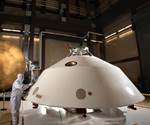Researchers develop carbon nanotube heat shield
A team of researchers from Florida State University is developing a design for for a carbon nanotube-based heat shield for use on satellites, rockets and jet aircraft.

Professor Zhiyong (Richard) Liang and research faculty member Ayou Hao holding pieces of carbon fiber-reinforced polymer composites with a protective heat shield made of a carbon nanotube sheet that was heated to a temperature of 1,900°C. Source | FSU
A team of researchers from Florida State University’s High-Performance Materials Institute (HPMI; Tallahassee, Fla., U.S.) is developing a design for for a carbon nanotube-based heat shield for use on satellites, rockets and jet aircraft. Their work is published in the November 2019 edition of the journal CARBON.
The team used sheets of carbon nanotubes (see CW’s primer on nanomaterial types and definitions) to build the heat shields. These sheets, also known as “buckypaper,” were soaked in a phenol resin to create a lightweight, flexible material that reportedly durable enough to protect the body of a rocket or jet from the intense heat it faces while flying.
According to Ayou Hao, a research faculty member at HPMI, existing heat shields are often very thick compared to the base they protect, while this design lets engineers build a very thin shield, like a sort of skin that protects the aircraft and helps support its structure.
After building heat shields of varying thicknesses, the researchers put them through several tests. One test involved applying a flame to the samples to see how they prevented heat from reaching the carbon fiber layer they were meant to protect. After that, the researchers bent the samples to see how strong they remained.
They found the samples with sheets of buckypaper were better than control samples at dispersing heat and keeping it from reaching the base layer. They also stayed strong and flexible compared to control samples made without protective layers of nanotubes. According to the researchers, the flexibility of the nanotubes means the sheets are less vulnerable to cracking at high temperatures compared to ceramics, a typical heat shield material. They are also lighter weight compared to traditional materials.
The project received second place among peer-reviewed posters at the 2019 National Space and Missile Materials Symposium and received third place at the Society for the Advancement of Material and Process Engineering 2019 University Research Symposium.
The project was partially supported by teh U.S. Air Force Office of Scientific Research.
Related Content
-
Plant tour: Middle River Aerostructure Systems, Baltimore, Md., U.S.
The historic Martin Aircraft factory is advancing digitized automation for more sustainable production of composite aerostructures.
-
The potential for thermoplastic composite nacelles
Collins Aerospace draws on global team, decades of experience to demonstrate large, curved AFP and welded structures for the next generation of aircraft.
-
Manufacturing the MFFD thermoplastic composite fuselage
Demonstrator’s upper, lower shells and assembly prove materials and new processes for lighter, cheaper and more sustainable high-rate future aircraft.

.jpg;width=70;height=70;mode=crop)














